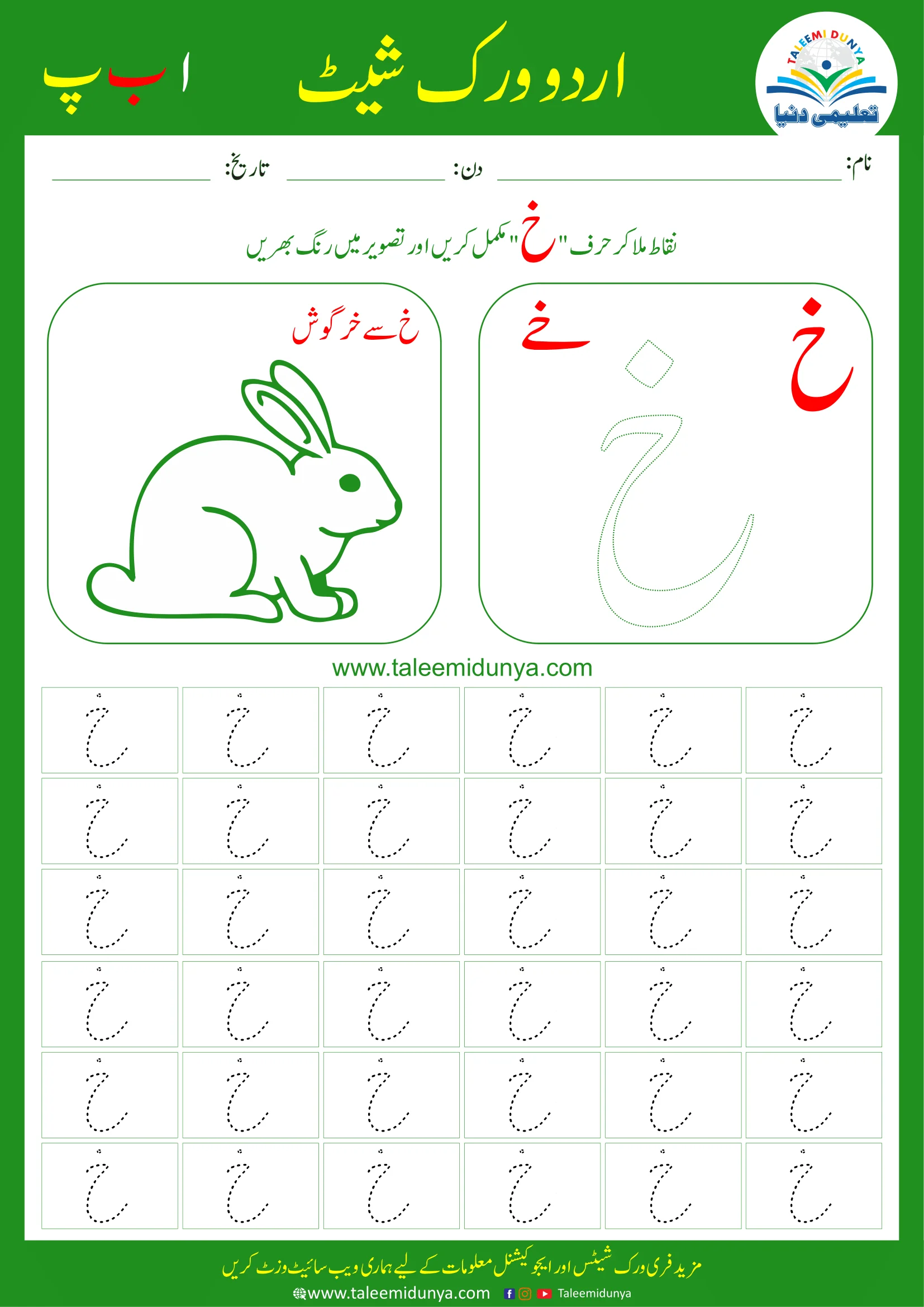Khay
Khay Urdu Worksheet
Khay Urdu Worksheet
Introduction to Khay Urdu Worksheet
As an educator or parent, you might often find yourself searching for effective educational resources that not only enhance learning but also instill a love for language. One such invaluable tool is the Khay Urdu Worksheet. This comprehensive guide will provide you with an in-depth understanding of these worksheets, elucidating their importance, components, and the myriad benefits they offer in Urdu language education.
What is a Khay Urdu Worksheet?
A Khay Urdu Worksheet is a specialized educational resource designed to help learners master the Urdu alphabet, specifically focusing on the letter 'Khay'. These worksheets are crafted to facilitate the learning process through engaging exercises and activities that promote both writing and recognition skills.
Importance of Learning Khay in Urdu
The letter 'Khay' is an integral part of the Urdu alphabet, representing not just a sound but also a cultural and linguistic connection. Mastering this letter is crucial for building a strong foundation in Urdu literacy. The Khay Urdu Worksheet aids in this by providing structured learning paths that enhance both comprehension and retention.
Components of a Khay Urdu Worksheet
Understanding the components of a Khay Urdu Worksheet is essential for utilizing it effectively. These worksheets are meticulously designed to include various elements that cater to different learning needs.
Basic Structure
The basic structure of a Khay Urdu Worksheet typically includes sections for tracing, writing practice, and visual recognition activities. This structure ensures a comprehensive approach to learning, addressing different aspects of language acquisition.
Types of Exercises Included
A variety of exercises are included in the Khay Urdu Worksheet to maintain engagement and promote effective learning. These might include tracing worksheet activities, fill-in-the-blank exercises, and matching games, all designed to reinforce the learning of the 'Khay' letter in a fun and interactive manner.
Creating Effective Khay Urdu Worksheets
Designing a Khay Urdu Worksheet requires careful consideration to ensure it meets educational standards while being engaging for learners.
Design Considerations
When creating a Khay Urdu Worksheet, it's important to consider the age and skill level of the learners. Worksheets should be visually appealing, with clear instructions and a logical flow that facilitates independent learning.
Incorporating Visuals and Illustrations
Visuals play a critical role in learning. Incorporating images and illustrations related to the 'Khay' letter can make the learning process more engaging. These visuals help in better retention and understanding, making the Khay Urdu Worksheet more effective.
Tips for Using Khay Urdu Worksheets in Classroom
Using Khay Urdu Worksheets in the classroom can significantly enhance the learning experience, provided they are used effectively.
Engaging Students
To engage students, it's important to incorporate interactive activities. Group exercises, peer reviews, and multimedia resources can complement the worksheets and make learning more dynamic and enjoyable.
Customizing Worksheets for Different Levels
Customization is key when using Khay Urdu Worksheets. Tailor them according to the proficiency levels of your students to ensure that each learner is challenged appropriately and can progress at their own pace.
Common Challenges and Solutions
While Khay Urdu Worksheets are a valuable resource, they can present certain challenges that need to be addressed for optimal effectiveness.
Addressing Student Difficulties
Students may face difficulties in mastering the 'Khay' letter due to its unique phonetic characteristics. Providing additional support through audio aids or personalized feedback can help overcome these challenges.
Overcoming Resource Limitations
Resource limitations can be a hurdle when implementing Khay Urdu Worksheets. Utilizing digital platforms like Freepik.com downloadable resources can offer a cost-effective solution.
Examples of Khay Urdu Worksheets
To illustrate the versatility of these worksheets, here are examples catering to different learning levels.
Worksheet for Beginners
A beginner-level Khay Urdu Worksheet might include basic tracing activities and simple word recognition exercises to introduce the letter 'Khay'.
Advanced Level Worksheet
For advanced learners, a Khay Urdu Worksheet could include complex sentence formation tasks and critical thinking exercises around the use of 'Khay'.
Benefits of Using Khay Urdu Worksheets
The use of Khay Urdu Worksheets in education offers numerous benefits, enhancing both language skills and cultural understanding.
Enhancing Language Skills
By providing structured practice, these worksheets enhance language skills, including writing, reading, and comprehension, thereby building a strong linguistic foundation.
Promoting Cultural Understanding
Learning the Urdu alphabet through Khay Urdu Worksheets also promotes cultural understanding, helping students appreciate the rich heritage and history of the Urdu language.
Conclusion: Maximizing the Use of Khay Urdu Worksheets
In conclusion, Khay Urdu Worksheets are a pivotal educational tool in the acquisition of Urdu language skills. By understanding their components, effectively creating and utilizing these resources, and addressing common challenges, educators can significantly enhance the learning experience. Embrace the creative potential of these worksheets and explore their versatile applications to maximize learning outcomes.
